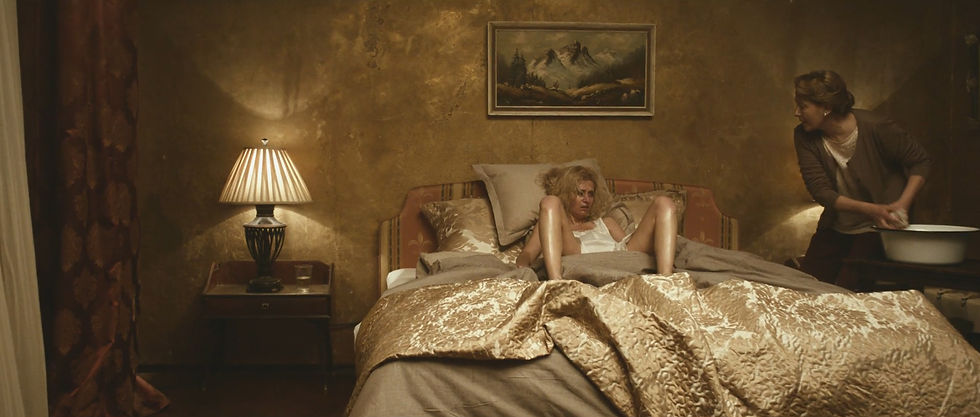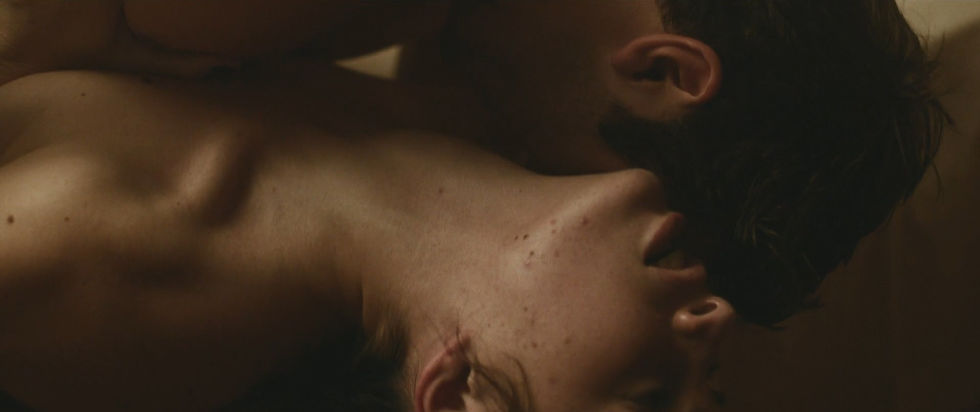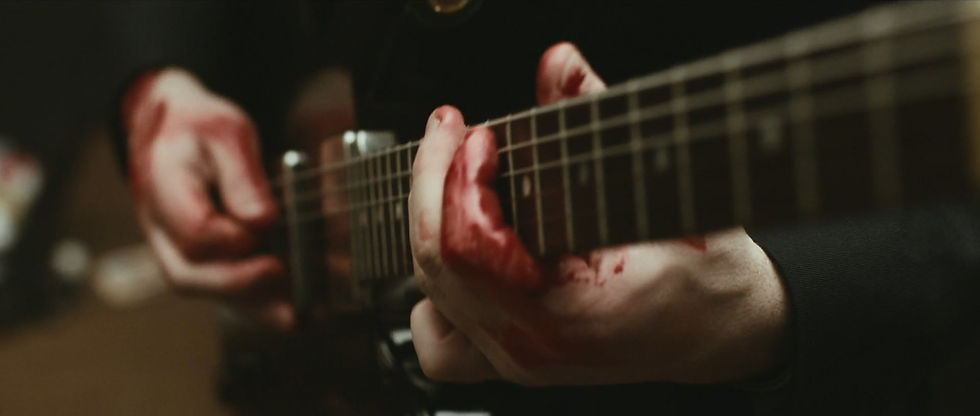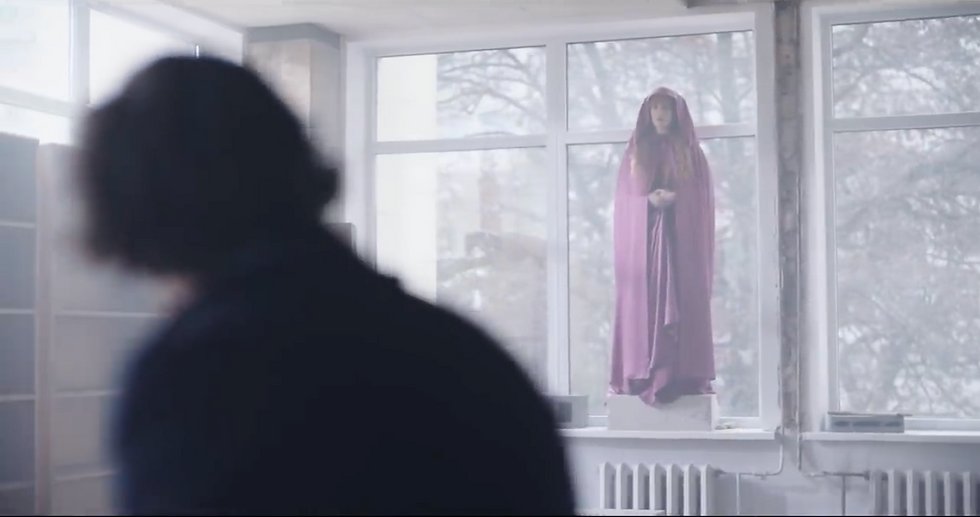LATE NIGHT: PAIN, PLEASURE AND WHAT CONNECTS US ALL
- Stephanie Zundel

- Apr 26, 2022
- 13 min read
Updated: May 9, 2022
The music video is a melting point – lyrics, made into song, meet visuals. The pairing of music and image can be realized in infinite ways, which makes the production of and engagement with music videos so captivating. Did you ever listen to a song and wonder how you would visually realize it or did specific images already pop up in your mind? Here comes a study about one way of interpreting the relationship between music/lyrics and visual narratives.
The theory: (Post-)Structuralism. The study object: Late Night* by Foals. The method: Subdividing the lyrics into lexias and asserting meanings and intertextual codes to them in a first step and then looking at the relation between these codes and the story-lines in the corresponding music video in a second step. This should reveal some interesting connections.
*Content warning: This video addresses and contains imagery of death/suicide. There is also nudity and sex which can be perceived or interpreted as violent and could be triggering. Moreover, there is (fake) blood present in several scenes.
Structure – Relation – Contrast
Structuralism is a cultural theory which has its roots in the 1950s. Its main ideas were developed in linguistics, but it has become a very productive perspective to discuss social, anthropologist, historical and philosophical questions. The main goal is to understand the underlying structures of thought and systems of meaning. Structuralism is sometimes criticized for assuming binary, stiff and cross-culturally homogeneous truths – Post-structuralism, which started to take form in the 1960s in France, builds up on the basic ideas of the latter and emphasizes the openness, heterogeneity and non-universality of truth and knowledge. The method later applied in this analysis stems from Roland Barthes, French philosopher, author and literary critic, who is mostly allocated in the post-structuralist movement which he significantly shaped.
When the Swiss linguist Ferdinand de Saussure separated 'the sign' from 'the signified' in the beginning of the 20th century, the arbitrariness of words and inter-relatedness of meanings became visible and the foundation for structuralism was laid: The sound of the pronounced word (sign) does not equal the object (the signified, its meaning). Rather, the relation of the sign to other signs creates the meaning of the signified.
In France, anthropologist Claude Lévi-Strauss was a key figure in the development of structuralist theory, and linguistic circles of structuralism existed in Prague and Moscow.
Linguistically and literarily structuralism emphasizes that meaning is not "inside things", it is not in the words (as de Saussure said), rather it is to be found "outside", in relation and contrast to other things, for example in the structures in which a text is embedded (Barry 40). To look at writing from a structuralist perspective then means to move away from it, often into "comparatively abstract questions of genre, history, and philosophy" (41) and to try and comprehend the networks, relations, contrasts between signs. Post-structuralism then highlighted the fact that this means that meaning is not stable and different meaning makers make different meanings. Mean!
In sum one could say: The meaning is not there, isolated, in the text, in the words – we must engage in a process of meaning making, look at the bigger picture and put the ideas found in relation. Because only by looking at the relation and contrast between words and ideas can we attribute meaning to them.
Late Night Stories
Currently, Foals are promoting their seventh album Life is Yours (2022), which will be released on June 17th. This video was released in 2013 as the third single of the band's third album Holy Fire. For Late Night they worked with Nabil, a renowned American director and photographer who has realized videos with Bon Iver, Frank Ocean, Billie Eilish and ROSALÍA, Anohni and many more. The product is dark, intense, oppressive – existential: Images of pain, lust, violence, ecstasy alternate and thicken into a climactic moment.

(Still, Nabil, "Late Night" by Foals, 2013)
After a Parental Advisory warning (on YouTube, not on Vimeo), the opening synthesizer chords of Late Night sound, accompanied by a pulse, a heartbeat. We are introduced to the location, a hotel in Romania, and an atmosphere that sets the scene: a snowy night. As the song progresses the hotel later reveals similarities to a puppet house – different rooms, of which the walls are permeable to the camera, are the sites of three main narratives.

(Still, Nabil, "Late Night" by Foals, 2013)
During intro and the first verse, the busy hotel bar: little tables, somber mood. Foals play on a tiny stage and are not cared for much by the guests. Throughout the video, however, we revisit this room, the band, the stage in between scenes; Foals' concert, the music, their song hold the three stories together, they are the anchor.
In the bar we meet one protagonist already, a middle-aged man in a suit and tie, lighting a cigarette, getting drunk, sweating, in a dark mood. When singer Yannis Philippakis ends the verse with "Calling out your name" the camera moves upwards from a portrait shot of his face, through the ceiling, and into the first hotel room. A man and a woman, making out on a hotel bed, are revealed to our gaze.The man undresses the woman and grabs her tightly as the second verse starts.

(Still, Nabil, "Late Night" by Foals, 2013)
The camera slides past them, through the wall into the next room: Here a pregnant woman is lying panting and sweating on the bed. Another woman is putting a wet cloth on her forehead.

(Still, Nabil, "Late Night" by Foals, 2013)
Without pause, the camera breaks through the wall again, into another hotel room: A man is facing the mirror. He takes off his white shirt and stares at himself intently.

(Still, Nabil, "Late Night" by Foals, 2013)
After this introduction of all three rooms, narratives and protagonists we return to the concert at the bar in the middle of the second verse. The suited man's drunkenness is progressing, he gets louder, is rude to the waitress. Philippakis sings: "I feel, I feel no shame - Oh now Mama do you hear my fear? - It's coming after me". All three rooms are visited again during a repetition of "Calling out your name". As the second verse ends, the singer's nose starts to bleed. A moment of calm: "Stay with me - Stay with me". Drinking and shouting at the bar, sex, birthing, the topless man takes off his belt, sensually strokes his neck and throat with it, scenes from the concert. From here on the pace gets faster and we switch rooms and stories more swiftly, the plots and the music thicken simultaneously as the third verse starts.
In quick shots the very physical, bodily visuals almost melt into each other, as do pain and pleasure. The belt is put around the neck, the sex is passionate, intense, violent (?), the woman giving birth is in pain, breathing heavily. A build up to"Happy now?", where both sound and stories come to a climax, and a release of tension with repetitions of "Stay with me". Then the guitar solo. The baby is born, the drunk business man escalates and gets hit by a woman. The pair is in ecstasy. It is unclear whether the hanging was intentional or an accident of auto-erotic practice, but as the suited man returns to his room, he finds his friend, relative business partner, lover (?) dead. Birth, Violence, Orgasm, Death.
The video ends with the sounds of heavy exhausted breathing, the first cries of the baby and the weeping of the middle-aged man overlaid.
Dividing of Text, Assigning of Codes

(Painting, Michelangelo Merisi da Caravaggio, Saint Jerome Writing, c. 1605 (detail))
In literary theory Roland Barthes is famous for his idea of The Death of the Author. The essay "La mort de l'auteur" was published in 1967; in a nutshell it argues that the author is completely irrelevant and the meaning of a text can be created by a reader alone.
Here I will apply the method that Barthes exemplified in his essay "Textual Analysis of a Tale By Edgar Poe", published in 1977. I will split up the lyrics into numbered parts, 'lexias', and then assign connotations and associations of meaning to them. This enables identifying different 'codes' that reappear and mark topical emphasis. (Barthes 263-264) The small leads to the big. What meanings are these lyrics are pointing towards, how are they distributed in the text – and how do they relate to the stories in the video?
TITLE
(1) Foals – Late Night
The title evokes an image of darkness. The text might have been written late at night or the scenes described or revived might have taken place late at night. An association: Late night thoughts.
VERSE 1
(2) Oh, I hoped that you were somebody,
Someone I could count,
To pull me to my feet again,
When I was in doubt
An 'I' talks directly to a 'you', with which it stands in relation somehow. I will call this the relation code. Specifically, the 'I' expresses disappointment about the you, hopes and expectations for support and reliability were not fulfilled. This is the hurt code.
(3) Oh now Mama, do you hear me,
Calling out your name? (2x)
These lines express the helplessness and need of support of the 'I'. It calls out to the mother, repeatedly asking whether it is heard. This displays a need, the question it initiates what I call the vulnerability code.
(4) Calling out your name.
This repetition adds to vulnerability.
VERSE 2
(5) Now I'm the last cowboy in this town,
Being the last of one's kind in a town paints a picture of loneliness, which is again a code.
(6) Empty veins and my plastic broken crown.
The loss or lack of blood, can stand for feeling dead, empty and weary. The broken crown made of plastic could be an image for destroyed illusions and hopes that were fake (plastic) from the very beginning. Maybe the crumbling of a persona, an ideal self-image? Hurt reappears.
(7) They said I swam the sea then ran aground,
The sea is enormous, the 'I' is small in comparison. This might indicate floating around, a bit lost, then getting back to safe ground, to feeling grounded. Running aground, however, also conjures the image of a stranded ship which lost its course.
(8) They said I once was lost, but now I'm truly found.
'They' (maybe friends) have made the 'I' aware of a positive turn. Considering lexia (7) being found and running aground have the same effect of returning back to safety after danger or chaos. Being truly found also resembles religious (saviour) language. I will call this the resolution code.
(9) And I know the place but not the ways,
The 'I' knows where it wants to go, but not how to get there. Related to lexia (10) I would argue this knowing and admitting alludes to both hurt and vulnerability.
(10) I feel, I feel no shame.
The 'I' does not feel ashamed for its state of mind, the helplessness and need for support. This is vulnerability again.
(11) Oh now Mama, do you hear my fear?
It's coming after me!
Again, a cry out for help. Vulnerability and relation.
(4) Calling out your name. (2x)
Vulnerability and relation are repeated.
(12) Stay with me. (2x)
The 'I' does not want to be alone, i.e. the images of loneliness, vulnerability and relation reappear. Repeated, reinforced. The phrase expresses a need for connection.
VERSE 3
(13) But you threw your heart away,
The 'you' either treated itself badly, or was literally heartless and treated the 'I' unkind. Hurt reappears.
(14) Oh, I know just what to say,
That the concord it can wait,
We've still got time to say.
The 'I' and 'you' are in discord, the 'I' hopes that this will change, as they still have time to talk. This adds to relation and resolution.
(15) And I know you ran away,
Oh, I know but I'm feeling okay.
The 'you' left the 'I'. This emphasizes the relation code. The 'I' realizes that this is a good thing. This also adds to the resolution, the situation is accepted.
(16) But now I found love, the feeling won't go,
Now I found love, the feeling won't go!
Since the 'I' has experienced the feeling of love once, it cannot let go of it easily. Relation reappears. Possibly connected with hurt.
(17) See you walk away!
The 'I' watches the 'you' leave. Relation is reinforced.
(18) Feeling okay, now!
The 'I' feels better now. Resolution.
(19) Happy now?
Read as a question for the 'you', this is a bit of a reproach or a challenge. The 'I' asks the 'you' whether this, i.e. its state of mind and their relation, is what they wanted. It can also be a question the 'I' asks itself – am I really happy now?
(12) Stay with me. (4x)
Repeating this lexia reinforces loneliness, vulnerability and relation.
My textual analysis left us with these codes: relation, hurt, vulnerability, loneliness, resolution (in order of appearance). They are indeed all recognizable in the music video.
Relation is the central aspect in all three stories. The businessman is shown in relation to the other people at the bar – his state of mind and his drunkenness get clearer as we see him relating to others more rudely and carelessly. Of course, at the end of the video a close relation to the man who hung himself is revealed – here this story line portrays hurt, vulnerability and loneliness, too – the man is struck by grief suddenly and vulnerably.
Relation is visible very literally as the pair in the first hotel room relate and meet in sexual activity – one could say that in the vulnerable, naked act of sex, feelings of hurt and loneliness can find an at least temporary resolution – climax, literally, would be the resolution of sexual tension. On a different analytical level: The pair engage in and the actress here is subjected to rather intense or even aggressive sexual interaction. This could be very consensual and wanted or not. Moreover, the camera focuses on her body in a much more intrusive way than on the actor's. This portrays the protagonist/actress as and makes her vulnerable or exposed and in my opinion this marks the video as a bit dated – it felt problematic to me and would be discussion-worthy.
The woman giving birth is shown in connection and relation to both her assistant and the baby being born. The act of birth, as separation and physically inflicts hurt/pain to both the mother and the child, who is being thrown into this cold world, leaving the warmth of the womb behind. Birth is a physically extreme situation, where I am sure one feels vulnerable and somewhat helplessly exposed to the process. It is also the climax and resolution of the process of pregnancy – a new chapter begins for both parent and child.
Regarding the single man who hangs himself – of his relation to the businessman we only learn as the video ends, yet his auto-erotic, intense moments before death, possibly make loneliness and vulnerability felt. Death we can re-frame – it is the final resolution in/of life.
While there are moments of connection, pleasure, pain and closure, in sum, relation seems to be the most dominant and underlying topic.

(Still, Nabil, "Late Night" by Foals, 2013)

(Still, Nabil, "Late Night" by Foals, 2013)

(Still, Nabil, "Late Night" by Foals, 2013)
This video and song tell a story of the human condition, the seeking of connection, the pleasure, pain, tensions and turbulations of life and of human relation. The fact that the microcosm that is this hotel, presents to us viewers like a puppet house where the inhabitants can be observed and the walls are permeable, underlines this 'life in a nutshell' sentiment. The introducing and concluding sounds, heartbeat – breathing, crying, mourning, form a circle. If we break this circle up into a linear timeline of an abstract arc of suspense we find a clear structure – heartbeat marks the beginning, an introduction of both song and protagonists, a steady build up, layering of complexity, both musically and in storytelling, a climax and then a winding down, until the songs and stories find closure.
This arc and parallel structure of song and story fit perfectly with Foals' intricate laying and building up of rhythm, density, lyrics to musical highlights and drops. The timeline can also be superimposed on a human lifespan – birth, growing, relations, connections, which go along with vulnerability, hurt, and feelings of loneliness, then, moments of climax, a question: Happy now? Then a lowering of energy and tension, approaching closure and resolution, death.
The constant transgressing of walls supports the idea of relation and inter-connectedness, both on the level of the shared experiences which are presented as well in the structural sense: Birth, love – sex, death/loss, they only make sense in relation to each other in the most literal structuralist sense – a death we mourn because of the life, the relations lived. We make meaning and order of life events by relating and finding similarities and contrast.
Reflections on the Method
As all the codes I assigned were quite easily identifiable in the story lines of the video, this kind of analysis seems to be fruitful. However, as we know by now, this whole interpretation is very arbitrary and individual. The codes identified are rather general topics that could be visually expressed in thousands of ways. Still, this approach is beneficial for an individual interpretation and helps getting aware about what you, individually, make of a song, of a music video.
This textual analysis was therefore one possible way of understanding these lyrics in relation to this music video. It does not uncover the meaning of the literary piece or video completely or definitely: The meaning is not stable, the interpretation to a degree arbitrary, from the division into lexias to the assertion of codes. Say, we find synonyms or words related to the code-words that I chose, this would again open new networks and nuances to interpret and emphasize, the opportunities are endless! Relation – connection, bond; hurt – pain, wound, harm; vulnerability – openness, need, at risk; loneliness – sadness, isolation; resolution – release, closure, end.
This is an approach you can play around with, you can try out this perspective elsewhere, too: Structuralists recognize the structure and relationality in language and transfer this idea to other realms: Popular culture becomes, as a structure, readable like a language, so does fashion – parts make up an assemblage, we can assign meaning to them by looking at the context and references, and then decode the combination of parts we encounter.
What might you find, wearing your structuralist glasses?
Blood

(Still, Nabil, "Late Night" by Foals, 2013)
To close the discussion of Late Night here are some words from the artists about their intentions for the video. In a making of video with NME Yannis Philippakis shares the following about the thought processes with Nabil:
"We were just coming up with dark ideas that seemed to fit the track, and we got kind of excited by this idea of blood being connected in the cycle of life. […] Each scene is basically connected with the presence of blood, and how blood is the thing that connects us all and keeps us alive."
A most literal visual realization of relation and connection.
(Re-)Sources
Barthes, Roland. "Textual Analysis of a Tale by Edgar Allan Poe." The Semiotic
Challenge. Trans. by Richard Howard. Berkley: University of California Press,
1994. 261-93.
Gallix, Andrew. "In Theory: The Death of the Author": https://www.theguardian.com/books/booksblog/2010/jan/13/death-of-the-author
"Late Night": https://www.youtube.com/watch?v=vP-HSoe7IAU
"Late Night Lyrics": genius.com. https://genius.com/Foals-late-night-lyrics
"Nabil Elderkin": https://en.wikipedia.org/wiki/Nabil_Elderkin
Nicholas, Tom. "The Death of the Author: WTF? Roland Barthes' Death of the Author Explained": https://www.youtube.com/watch?v=B9iMgtfp484
Renschaw, David. "Foals reveal near-death experience on set of 'Late Night' video".






Comments